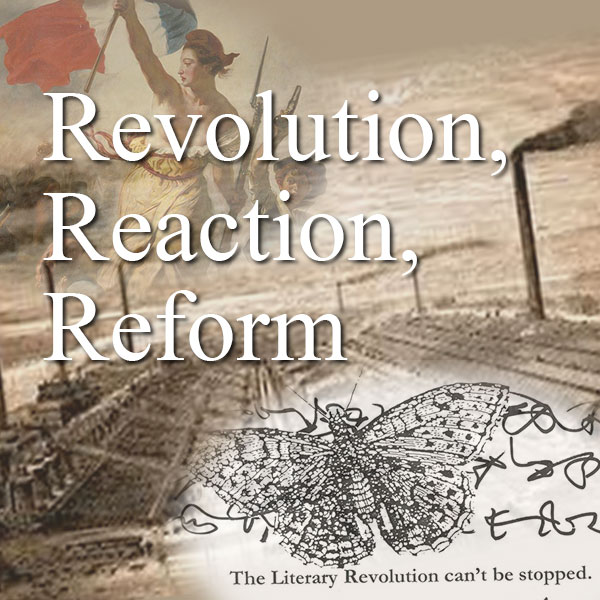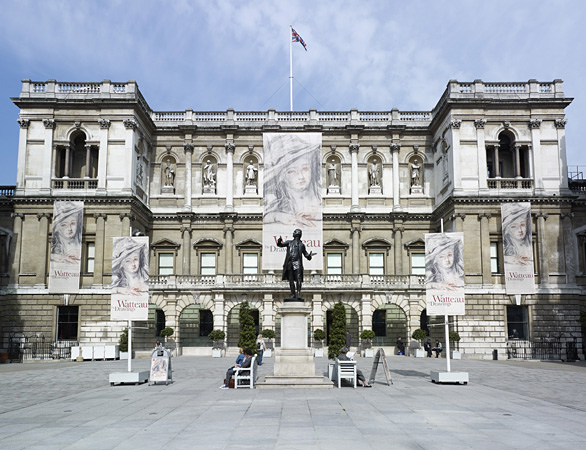MSSU ENG272 - Fall 2020 Dashboard
Participants
- ‹ previous
- 2 of 2
Description
 British Literature II: Revolution, Reaction, Reform examines British literature from the late eighteenth century to the present, a period that witnessed the American and French Revolutions, slave revolts such as the Haitian Revolution, a “revolution in female manners,” the Industrial Revolution, the twentieth-century revolutionary wave in Europe, as well as World War I and World War II, and, of course, artistic revolutions. We will consider how the authors and literary works of this period might be reacting to change, advocating for reform, or participating in literary revolutions—whether revolution is understood in the sense of “revolving” or of “revolting,” going full circle to return to a previous (more perfect?) time or experiencing/effecting a great alteration or rupture.
British Literature II: Revolution, Reaction, Reform examines British literature from the late eighteenth century to the present, a period that witnessed the American and French Revolutions, slave revolts such as the Haitian Revolution, a “revolution in female manners,” the Industrial Revolution, the twentieth-century revolutionary wave in Europe, as well as World War I and World War II, and, of course, artistic revolutions. We will consider how the authors and literary works of this period might be reacting to change, advocating for reform, or participating in literary revolutions—whether revolution is understood in the sense of “revolving” or of “revolting,” going full circle to return to a previous (more perfect?) time or experiencing/effecting a great alteration or rupture.
We'll be using the following texts at COVE Studio in the anthology British Literature II (MSSU), Fall 2020:
Wordsworth, William, "We Are Seven" (1798)
Coleridge, Samuel Taylor, "Eolian Harp" (1795)
Coleridge, Samuel Taylor, "Metrical Feet: Lesson for a Boy"
Shelley, Mary, Frankenstein; or, The Modern Prometheus (1818)
Browning, Robert, "Porphyria's Lover" (1836)
Browning, Robert, "My Last Duchess" (1842)
Browning, Robert, "Soliloquy of the Spanish Cloister” (1842)
Tennyson, Alfred, "The Lady of Shalot" (1832 and 1842)
Browning, Elizabeth Barrett, "The Cry of the Children" (1843)
Hood, Thomas, "The Song of the Shirt" (1843)
Brooke, Rupert, "The Soldier" (1914)
Eliot, T. S., "The Love Song of J. Alfred Prufrock" (1915, 1917)
Woolf, Virginia, "The Mark on the Wall" (1921)
Auden, W.H., "Musée des Beaux Arts" (1939, 1940)
Thomas, Dylan, "Do Not Go Gentle into That Good Night" (1951)
Galleries, Timelines, and Maps
There is no content in this group.
Individual Entries
Liverpool only appears in Noth and South four times and it is talked about in passing by. There is not much to say about it other than there were times when Margaret talked about sailing through Liverpool or passing by it or when Mr. Thornton talked about getting into stocks in Liverpool; this would likely be due to the exponential growth and wealth in the city and the British Industrial Revolution. In the 1840's-50's Liverpool was growing very quickley and very wealthy. This was shown by the imposing buildings that had been built and the growth of the port industry in the city. The growth of Liverpool was due to the British Industrial Revolution. Wirral Books states that "the Industrial Revolution in Liverpool saw the city emerging as one of the chief centers of cotton and slave trade."
My...
more
William Wordsworth was born in Cockermouth Cumbria. He spent years in both the United Kingdom and Europe. He eventually returned home where he spent fifty years living until his death in 1850.
https://www.thelakedistrict.org/historical-figures/william-wordsworth/
...
moreBetween 1799-1825 Henry Fuseli became not only a Art Proffessor but also a Keeper of the school. The Royal Academy Summer's exhibite is were Henry Fuseli famoust painting The Nightmare is located and first showned in 1782. Many of Henry Fuseli art work is inspired by Michelangelo, John Milton, and Shakespeares plays such as, Macbeth, King Lear, and A Midsummers Night's Dream. He was famous for his artistic style of drawings of nude figures struggling and violent pose showing varies of emotions throughout the time.

https://www.royalacademy.org.uk/art-artists/name/henry-fuseli-ra

 ...
...